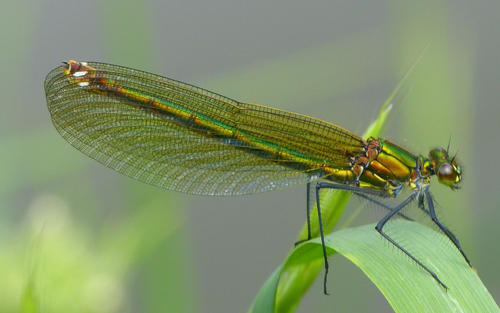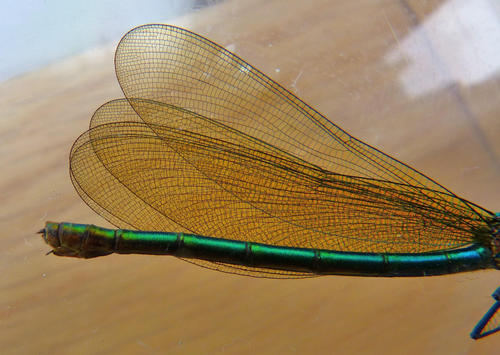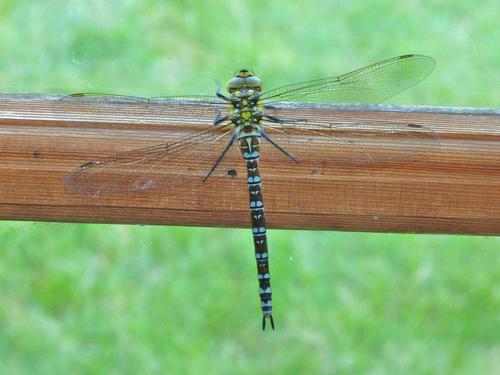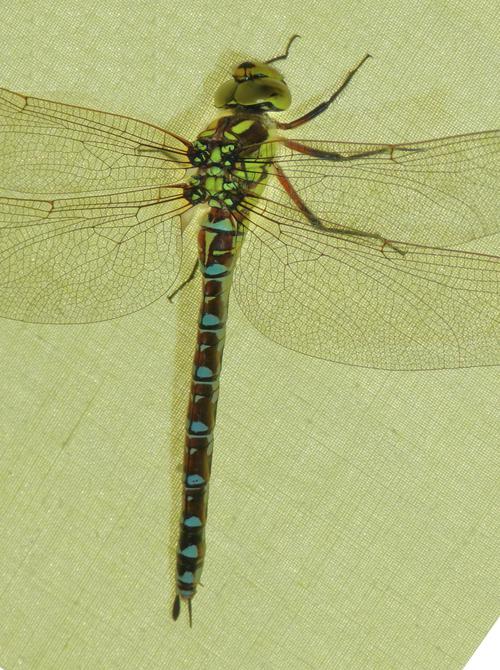Dragonflies in Worcestershire 2012
Mike Averill
What a year of weather extremes; from drought in March to floods in July. The summer (Apr-Sep) was very wet with over 150% of annual average rainfall compared to 58% for the same period in 2011. Consequently it was a case of picking the days very carefully for insect watching. The only consolation would be that aquatic insects would not need to search far for wetland habitat.
After a very warm dry start in March when early flowering plants did well for pollination, a wet and cool April brought frosts and this delayed much insect activity. The Common Clubtail Gomphus vulgatissimus didn’t emerge until late May, as much as 14 days later than in 2011 but it wasn’t a bad year for them and they all emerged in a very short two week period making up for lost time.
It has been mentioned in previous years that the Beautiful Demoiselle Calopteryx virgo has been doing well and this was the case again with the species showing in as many numbers and locations as the more commonly encountered Banded Demoiselle Calopteryx splendens. Twenty years ago a walk up the river Teme would reveal few Beautiful demoiselles other than in the minor tributaries but this year they were to be seen alongside the Banded Demoiselle in most places. The species is also being reported from smaller rivers east of the Severn as well.
All dragonflies and all the damselflies except for the demoiselles have a true colour cell in the wing (pterostigma). Of the demoiselles only the females have the equivalent to a pterostigma in that it is a coloured area of cells near the front edge of the wing (Fig. 1.) as opposed to the enlarged single cell as seen in all other dragonflies. Sometimes this is missing even in the females and is rarely recorded but a Banded Demoiselle without one was seen in Kidderminster in late May this year (Fig. 2.).
Immigration of dragonflies from the continent occurred as usual in to southern England but only the Red-veined Darters Sympetrum fonscolombii reached Worcs this time with a few being seen at Grimley Gravel Pits, Pirton Pool, and a few at Kemerton gravel pits.
The Scarce Chaser Libellula fulva continues to expand its range with records occurring at Pendock, Churchill, Hurcott and most surprisingly at Hillditch Pool. All those sites are pools and so are not really the classic river habitat that it is normally associated with this species. Of those sites Hillditch is perhaps the most surprising as there was quite a lot of breeding activity and this site, although small, could be mistaken for a river as for about a hundred metres it does look like a very slow flowing medium sized river. Like most dragonflies the males of the Scarce Chasers are the most noticeable as they adopt display territories but females were seen as well with up to 12 individuals pairing up. Next season will be anticipated with interest to see if the population increases at this site.
The Small Red-eyed Damselfly Erythromma viridulum appeared to be making a relentless push westwards after initially appearing in Essex in 1999, but there seems to be some evidence that it is slowing its progress. It first appeared in Worcestershire in 2006 and has centred its activity at Croome Park. Last year the numbers were in the hundreds possibly thousands but this year they were down to a few hundred. That may be weather related and it could be due to less algal growth, one of its preferred plants, which being more likely to develop in hot weather, is also weather related. The damselfly prefers water milfoil and hornwort but is quite happy on blanket weed. Attempting to estimate damselfly numbers is rather subjective but having the started transect counts at Croome this year has helped make comparisons.
There is not much colour variation in mature dragonflies in the UK but it can be seen in the Aeshnid species, specifically the Southern Hawker Aeshna cyanea. Both the males and females can be seen with all the abdominal colour spots showing as light blue rather than green and the thoracic shoulder stripes appear yellow rather than green (Figs. 3 &4.) It is not mentioned in most identification books and the cause is not fully understood but is thought to be either related to temperature, to stages of development or is a colour form.
Colours will generally go lighter with heat, the point being to enable incoming radiation to be reflected back out. The reverse is the case in cooler weather and may be why the Highland Darter Sympetrum nigrescens is darker being located in Scotland where radiation will be less. This theory is not favoured by observers in Scandinavia where they argue that it should, in that case, be much more commonly seen in the cooler climates.
With ageing, colours normally change in the days immediately after emergence as the individual matures. In the later stages of adult life, individuals will also develop a darker colour and some very old adults like females of the Common Darter Sympetrum striolatum will start to take on the hues of the males.
Many of the examples cited as having blue colouration appear to have recently emerged and it could be that they are just a transitional phase before adopting the normal colours. Again if this is the cause it is strange it isn’t seen more often in a well observed group like dragonflies.
Some damselflies like the Ischnurids, show colour variation in females, the Blue-tailed Damselfly Ischnura elegans has various colour forms and this is called polychromatism (only the females show this) whereas polymorphism is where the males and females show colour differences between each other. Polychromatism isn’t usually encountered in the larger UK dragonflies and so blue forms in the Aeshnids is unusual. We have had a handful of these sightings in Worcestershire all in the Southern Hawker. Both males and females can show the effect. In order to test the temperature and ageing theory a live specimen was collected this summer near Pershore where there were two females hawking a hedgerow. It was fed on mosquitoes in a summer house for four days until it unfortunately broke its neck trying to get out, but in all the time it was there, the colour didn’t change at all (photos). This was despite the temperature ranging from 9 to 27°C. Perhaps this individual can reveal something from its DNA.
The damp cool summer continued in to September and so the flying season was all but over by mid September with just the hardy Common Darters, Migrant and Southern Hawkers Aeshna mixta and Aeshna cyanea making the odd appearance on warmer days.
2012 was a bit disappointing for the last year of recording for the National Atlas, nevertheless the survey time is complete and the full details will appear in the next issue of the Worcestershire Record.
Images
Fig. 1. Banded Demoiselle (f) with pterostigma. Mike Averill
Fig. 2. Banded Demoiselle (f) without pterostigma. Mike Averill
Fig. 3. Southern Hawker (f) blue form. Mike Averill
Fig. 4. Southern hawker (f) blue form side view.Mike Averill



